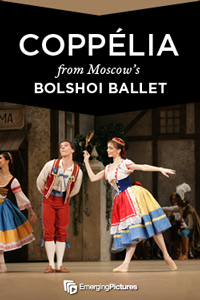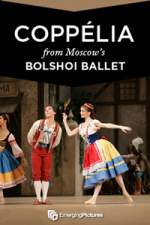Coppelia- Bolshoi
Coppelia- Bolshoi
COPPELIA
Leo Delibes
From the Bolshoi Theatre, Moscow
Running time 158 minutes including 2 intermissions
A doll come to life, love triangles, illusions, doubles – the story of Coppelia is just as intriguing and fanciful today as it was in 1870! From the Bolshoi Ballet; Original choreography by Marius Petipa recreated by Sergei Vikharev. Starring Viacheslav Lopatin and Natalia Osipova.
Libretto by Charles Nuitter and Arthur Saint-Leon, after the stories by E.T.A. Hoffmann
Choreography: Sergei Vikharev, after Marius Petipa and Enrico Cecchetti
Set Designer: Boris Kaminsky
Costume Designer: Tatiana Noginova
Music Director: Igor Dronov
Lighting Designer: Damir Ismagilov
Conductor : Igor Dronov
CAST
Swanilda ~ Natalia Osipova
Frantz ~ Vyacheslav Lopatin
Coppelius ~ Gennadi Yanin
Eight Friends ~ Xenia Kern, Daria Khokhlova, Victoria Litvinova, Yulia Lunkina, Anna Okuneva, Yanina Parienko, Svetlana Pavlova and Anna Tikhomirova
Coppelia (Automaton) ~ Nadezhda Gredasova
Lord of Manor ~ Alexander Fadeyechev
Burgomaster ~ Alexander Petukhov
Mazurka ~ Anna Antropova, Anastasia Meskova, Yevgeny Golovin and Igor Tsvirko
Czardas ~ Kristina Karasyova and Vitaly Biktimirov
L'Aurore (Dawn) ~ Yekaterina Krysanova
La Priere (Prayer) ~ Anna Nikulina
Le Travail (Work) ~ Anastasia Yatsenko
Ensemble ~ Daria Khokhlova, Svetlana Pavlova, Maria Prorvich and Olga Tubalova
Folie (Folly) Anna Tikhomirova
Program Note
Serge Diaghilev famously described Coppélia as “the most adorable ballet in the world, a unique pearl in the history of dancing.” Unlike most classical ballets, Coppélia is a comedy. It was designed to be charming, tender and sweet at a time when political tensions were high and signs of impending revolution filled the streets of Paris.
Composer Leo Delibes, always in line with the pulse of the times, eschewed theatrical trends of irony and mockery and instead gave Parisians a ninety minute escape into a zone of total cultural peace and social stability. Coppélia was the first ballet to incorporate folk dances into the choreography and while in 1870 this might have implied a sense of futility and doom, what endures in today’s production is its carefree quality of lightness and romance.
In its present form, Coppélia is a unique example of a unified Paris-St. Petersburg choreographic style. Although Arthur Saint-Léon notated his original version of Coppélia in 1870, contemporary productions are based on Marius Petipa’s 1884 restaging, which included many changes and additions. The result of this is a ballet that merges the complementary strengths of both choreographers. Saint-Léon was brilliant when it came to solo variations and small ensembles, in which he demonstrated both French elegance and the French sense of measure. Petipa, on the other hand, embodied the grand style of St. Petersburg - perfect form and full-blown corps de ballet compositions. Even more importantly for Coppélia, Saint-Léon was prone to theatrical playfulness while the usually cautious Petipa always strove for pure form and strict lines. The inherent tension in these two choreographers’ styles distinguishes Coppélia within the Classical canon as a ballet that is as charmingly playful as it is choreographically well conceived.
Sources: "The End of a Beautiful Era: For Whom the Bell Tolls" by Dmitry Renansky and "The Riddles of Coppélia" by Vadim Gaevsky
Edited by Kathleya Afanador
Leo Delibes
From the Bolshoi Theatre, Moscow
Running time 158 minutes including 2 intermissions
A doll come to life, love triangles, illusions, doubles – the story of Coppelia is just as intriguing and fanciful today as it was in 1870! From the Bolshoi Ballet; Original choreography by Marius Petipa recreated by Sergei Vikharev. Starring Viacheslav Lopatin and Natalia Osipova.
Libretto by Charles Nuitter and Arthur Saint-Leon, after the stories by E.T.A. Hoffmann
Choreography: Sergei Vikharev, after Marius Petipa and Enrico Cecchetti
Set Designer: Boris Kaminsky
Costume Designer: Tatiana Noginova
Music Director: Igor Dronov
Lighting Designer: Damir Ismagilov
Conductor : Igor Dronov
CAST
Swanilda ~ Natalia Osipova
Frantz ~ Vyacheslav Lopatin
Coppelius ~ Gennadi Yanin
Eight Friends ~ Xenia Kern, Daria Khokhlova, Victoria Litvinova, Yulia Lunkina, Anna Okuneva, Yanina Parienko, Svetlana Pavlova and Anna Tikhomirova
Coppelia (Automaton) ~ Nadezhda Gredasova
Lord of Manor ~ Alexander Fadeyechev
Burgomaster ~ Alexander Petukhov
Mazurka ~ Anna Antropova, Anastasia Meskova, Yevgeny Golovin and Igor Tsvirko
Czardas ~ Kristina Karasyova and Vitaly Biktimirov
L'Aurore (Dawn) ~ Yekaterina Krysanova
La Priere (Prayer) ~ Anna Nikulina
Le Travail (Work) ~ Anastasia Yatsenko
Ensemble ~ Daria Khokhlova, Svetlana Pavlova, Maria Prorvich and Olga Tubalova
Folie (Folly) Anna Tikhomirova
Program Note
Serge Diaghilev famously described Coppélia as “the most adorable ballet in the world, a unique pearl in the history of dancing.” Unlike most classical ballets, Coppélia is a comedy. It was designed to be charming, tender and sweet at a time when political tensions were high and signs of impending revolution filled the streets of Paris.
Composer Leo Delibes, always in line with the pulse of the times, eschewed theatrical trends of irony and mockery and instead gave Parisians a ninety minute escape into a zone of total cultural peace and social stability. Coppélia was the first ballet to incorporate folk dances into the choreography and while in 1870 this might have implied a sense of futility and doom, what endures in today’s production is its carefree quality of lightness and romance.
In its present form, Coppélia is a unique example of a unified Paris-St. Petersburg choreographic style. Although Arthur Saint-Léon notated his original version of Coppélia in 1870, contemporary productions are based on Marius Petipa’s 1884 restaging, which included many changes and additions. The result of this is a ballet that merges the complementary strengths of both choreographers. Saint-Léon was brilliant when it came to solo variations and small ensembles, in which he demonstrated both French elegance and the French sense of measure. Petipa, on the other hand, embodied the grand style of St. Petersburg - perfect form and full-blown corps de ballet compositions. Even more importantly for Coppélia, Saint-Léon was prone to theatrical playfulness while the usually cautious Petipa always strove for pure form and strict lines. The inherent tension in these two choreographers’ styles distinguishes Coppélia within the Classical canon as a ballet that is as charmingly playful as it is choreographically well conceived.
Sources: "The End of a Beautiful Era: For Whom the Bell Tolls" by Dmitry Renansky and "The Riddles of Coppélia" by Vadim Gaevsky
Edited by Kathleya Afanador
Genre
Ballet
Runtime
148
Language
English
Played at
Claremont 5 6.04.11 - 6.04.11
Town Center 5 6.04.11 - 6.04.11
Monica Film Center 6.04.11 - 6.04.11
Playhouse 7 6.04.11 - 6.04.11
Coppelia- Bolshoi Get Tickets
There are currently no showtimes for this film. Please check back soon.

